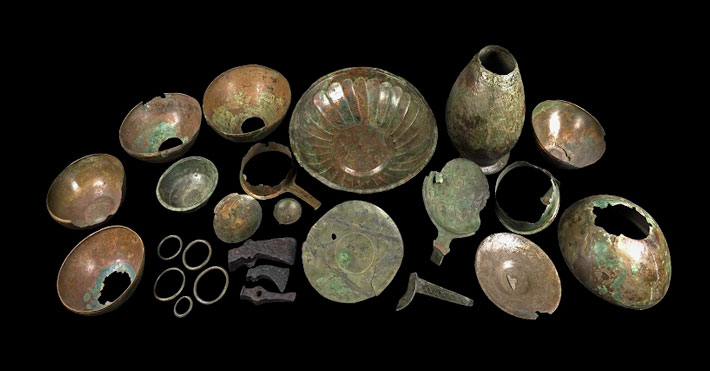 NEWCASTLE UPON TYNE, ENGLAND—According to a statement released by Newcastle University, a study of the Knaresborough Hoard has been conducted by archaeologist Jessica De Maso and her colleagues at Newcastle University. The 30 objects in the Knaresborough Hoard were discovered in an unknown bog in the British Isles and donated to the Yorkshire Museum in 1864 by Thomas Gott, an iron monger and town councilor who lived in Knaresborough but did not reveal where he had discovered the hoard. Made mostly of bronze, the hoard now includes a large fluted bowl with a scalloped edge, a bronze vessel handle, and several bowls, strainers, and oval plates. X-ray fluorescence analysis shows that many of the items, which would have resembled gold when polished, had been repaired in antiquity. The study suggests that the artifacts may have been buried near a Roman villa or settlement situated in northern England in the Vale of Mowbray, which is located about two miles from Knaresborough. During the Roman period, two roads ran through the area, including a route to York and Hadrian’s Wall. De Maso also thinks there may have once been additional items in the hoard that were mistakenly melted down in Gott’s foundry. To read about a bronze hoard found in East London, go to "Tool Time."
NEWCASTLE UPON TYNE, ENGLAND—According to a statement released by Newcastle University, a study of the Knaresborough Hoard has been conducted by archaeologist Jessica De Maso and her colleagues at Newcastle University. The 30 objects in the Knaresborough Hoard were discovered in an unknown bog in the British Isles and donated to the Yorkshire Museum in 1864 by Thomas Gott, an iron monger and town councilor who lived in Knaresborough but did not reveal where he had discovered the hoard. Made mostly of bronze, the hoard now includes a large fluted bowl with a scalloped edge, a bronze vessel handle, and several bowls, strainers, and oval plates. X-ray fluorescence analysis shows that many of the items, which would have resembled gold when polished, had been repaired in antiquity. The study suggests that the artifacts may have been buried near a Roman villa or settlement situated in northern England in the Vale of Mowbray, which is located about two miles from Knaresborough. During the Roman period, two roads ran through the area, including a route to York and Hadrian’s Wall. De Maso also thinks there may have once been additional items in the hoard that were mistakenly melted down in Gott’s foundry. To read about a bronze hoard found in East London, go to "Tool Time."
Bronze Hoard From Roman Britain Analyzed
